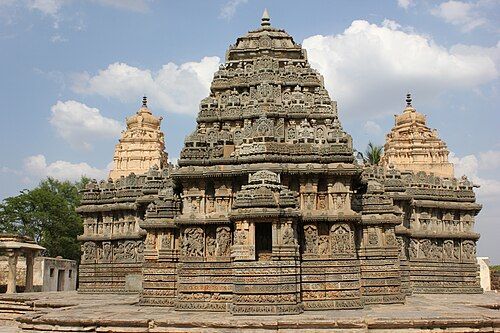Lakshmi Narasimha Temple, Nuggehalli
Lakshmi Narasimha Temple, Nuggehalli: A 13th-Century Hoysala Gem

The Lakshmi Narasimha temple is a 13th-century Hindu temple showcasing exquisite Hoysala architecture in Nuggehalli village, Hassan district, Karnataka, India. This trikuta (three shrine) Vaishnava complex is dedicated to Keshava, Lakshmi Narasimha, and Venugopala. It was built in 1246 CE by Bommanna Dandanayaka, a commander in the Hoysala Empire during the rule of King Vira Someshwara.
The temple is notable for its Vaishnava reliefs, as well as Shaiva reliefs featuring Harihara, Dakshinamurti, Chandikesvara, and Ganesha. It also includes Shakti reliefs of Durga Mahisasuramardini, dancing Lakshmi, and Saraswati, alongside Vedic deities such as Surya and Brahma. The lower sections of the walls depict scenes from the Hindu epics and the Bhagavata Purana. The artwork, completed and signed by the renowned Hoysala artist Mallitamma, is particularly noteworthy.[1]
Location and Date
Nuggehalli, also referred to as Nuggihalli or Nuggelli, is situated in Channarayapatna taluk of Hassan district in Karnataka state, India. It is located on the Tiptur-Channarayapatna state highway, approximately 50 km from Hassan city (via NH 75 and SH 47) and about 80 km southeast of Halebidu. The town enjoys good road connectivity with Bangalore, the state capital.[2]
Before the 14th century, the town was known as Vijaya Somanathapura and gained prominence as an agrahara (place of learning) during the time of Bommanna Dandanayaka. The Lakshmi Narasimha temple was erected in 1246 CE by Bommanna Dandanayaka, a commander in the Hoysala Empire under King Vira Someshwara's rule. It stands as a fine example of 13th-century Hoysala architecture. The Sadashiva temple, another significant structure built around the same period, is located a short distance away in Nuggehalli.[2][3]
Description
Floor plan of the Lakshminarasimha temple, Nuggehalli Lakshmi Narasimha temple, view from the southwestern corner Shrine outer wall with projecting minor shrine (aedicula) in Lakshmi Narasimha temple at Nuggehalli
This temple exemplifies a richly decorated Hoysala temple built in the trikuta (three towers) vimana (shrine) style, adorned with exquisite sculptures on its walls.[4] The construction material is Chloritic Schist, commonly known as Soapstone)[5], and the temple rests on a jagati (platform) that closely mirrors the temple's plan.[6][7]
The original temple's size was relatively small, to which a larger open mantapa (hall) was added later. The three shrines are positioned around a central closed ranga-mantapa featuring 9 "bays" (compartments between four pillars).[8] The ceiling of the closed mantapa is supported by four lathe-turned pillars and exhibits a deeply domed center.[9] The central shrine is the most prominent and boasts a large tower. This shrine includes a vestibule connecting it to the mantapa (hall). Consequently, the vestibule also has a tower (or superstructure, shikhara) that appears as a shorter extension of the main tower, known as the sukanasi. According to Foekema, it resembles the "nose" of the main tower.[10] The other two shrines have smaller towers and, lacking a vestibule to connect them to the central mantapa, do not have a sukanasi.[10] The three shrines house the images of Venugopala, Keshava, and Lakshmi Narasimha, all avatars of Vishnu.[3][11]
From the exterior, the temple initially appears as an ekakuta (single tower and shrine) temple because the two lateral shrines are simple extensions of the mantapa's wall. Their towers were added later. This is a classic illustration of a trikuta (three shrines and towers) that gives the impression of an ekakuta.[12][13] A large open hall with tall pillars was added in later periods, making the original porch and closed mantapa seem like the inner part of the temple. The central shrine has five projections per side, and its tower is complete, although it has lost its kalasha (decorative structure on top).[12][10][14] As the shrine has a square plan, the topping roof (a helmet-like sculpted stone) follows the same design. Three tiers of decorative smaller roofs, each bearing its own kalasa, form the body of the main tower.[14] The superstructure atop the vestibule (forming the nose) has only two tiers of decorative roofs, explaining why the sukanasi looks like an extension of the main tower. The two lateral shrines also have five projections per side. The tops of these shrines and the wall of the mantapa are crowned with a row of decorated roofs, similar to the main shrine.[3][12][14]
According to art critic Gerard Foekema, the temple exhibits a "newer" Hoysala style,[15] featuring two eaves running all around the temple below the vimana's superstructure where the roof meets the outer walls.[16] The upper eaves projects about half a meter from the wall. A second eaves runs approximately a meter below the upper one, with decorative miniature towers (aedicule) between them. The wall images of Hindu deities and their attendants are located below the lower eaves, totaling 120 sculptured panels. Below these are six moldings of equal size adorned with decorations in frieze. Historian Kamath identifies this as the "horizontal treatment" characteristic of later Hoysala temples.[15][17]
The six moldings at the base of the wall are divided into two sections. Starting from the base where the wall meets the jagati, the first horizontal molding depicts a procession of elephants, above which are horsemen, followed by a band of foliage on the third. The second horizontal section begins with detailed depictions from the Hindu epics and puranic scenes. Above this are two friezes of yalis (or makara, an imaginary beast) and hamsas (swans). The vimana tower is divided into three horizontal sections and is even more ornate than the walls.[3][15][18][19]
The images in the panels are predominantly Vaishnava in faith and are attributed to two well-known Hoysala sculptors, Baichoja and Mallitamma.[20] However, consistent with many Hindu temples, other traditions are also represented, including a few images of the god Shiva in the form of Bhairava along with his consort Bhairavi. Baichoja's sculptures are on the south side of the temple and, according to Foekema, possess a certain peace and dignity. Mallitamma's sculptures are on the north side and, while not as refined in Foekema's view, are lively and display greater variety.[11]
